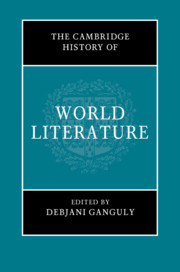Book contents
- The Cambridge History of World Literature
- The Cambridge History of World Literature
- Copyright page
- Contents
- Figures
- Contributors
- Acknowledgements
- Introduction
- Part I Genealogies
- 1 Ancient World Literature
- 2 The Silk Roads of World Literature
- 3 Arabic Literary Prose, Adab Literature, and the Formation of Islamicate Imperial Culture
- 4 Worldmaking and Early Modernity: Cartographic Poesis in Europe and South Asia
- 5 Colonial Philology and the Origins of World Literature
- 6 Globalism’s Prehistory: Technologies of Modernism
- 7 After 1945: Holocaust Memory, Postcoloniality, and World History
- 8 World Literature after 1989: Revolutions in Motion
- Part II Thinking the World
- Part III Transregional Worlding
- Part IV Cartographic Shifts
- Part V World Literature and Translation
- Part VI Poetics, Genre, Intermediality
- Part VII Scales, Polysystems, Canons
- Part VIII Modes of Reading and Circulation
- Part IX The Worldly and the Planetary
- Index
- References
3 - Arabic Literary Prose, Adab Literature, and the Formation of Islamicate Imperial Culture
from Part I - Genealogies
Published online by Cambridge University Press: 17 August 2021
- The Cambridge History of World Literature
- The Cambridge History of World Literature
- Copyright page
- Contents
- Figures
- Contributors
- Acknowledgements
- Introduction
- Part I Genealogies
- 1 Ancient World Literature
- 2 The Silk Roads of World Literature
- 3 Arabic Literary Prose, Adab Literature, and the Formation of Islamicate Imperial Culture
- 4 Worldmaking and Early Modernity: Cartographic Poesis in Europe and South Asia
- 5 Colonial Philology and the Origins of World Literature
- 6 Globalism’s Prehistory: Technologies of Modernism
- 7 After 1945: Holocaust Memory, Postcoloniality, and World History
- 8 World Literature after 1989: Revolutions in Motion
- Part II Thinking the World
- Part III Transregional Worlding
- Part IV Cartographic Shifts
- Part V World Literature and Translation
- Part VI Poetics, Genre, Intermediality
- Part VII Scales, Polysystems, Canons
- Part VIII Modes of Reading and Circulation
- Part IX The Worldly and the Planetary
- Index
- References
Summary
This chapter addresses how Arabic, besides being the scriptural and liturgical language of Islam, came to be the lingua franca of a world empire and its literary heritage. The chapter is divided into two parts, with the first subdivided into three sections examining the professional and literary careers of three chancellery secretaries of the late Umayyad empire, namely, Sālim Abū-l-ʿAlāʾ, ʿAbd-al-Ḥamīd al-Kātib, and Ibn-al-Muqaffaʿ, who briefly also served the early ʿAbbāsid dynasty; and how their contributions, both of translations and original works, laid the foundations of Islamicate imperial culture and of adab literature—a new style of Arabic written prose which, by way of translation, was to become part of premodern world literature. The second part of the chapter provides a brief survey of the genres, subgenres, and audiences of the literatures of adab within the Arabic literary tradition of the Middle Ages.
- Type
- Chapter
- Information
- The Cambridge History of World Literature , pp. 80 - 108Publisher: Cambridge University PressPrint publication year: 2021
References
- 1
- Cited by

